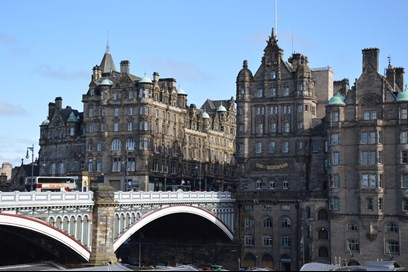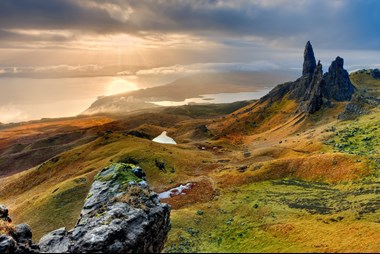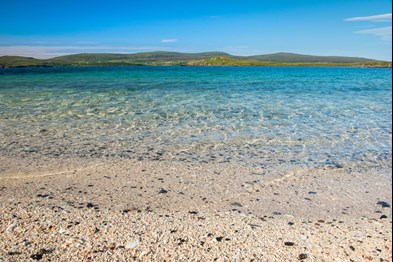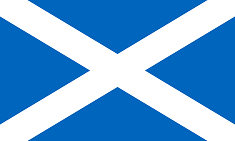Scotland has perhaps the worst weather of any country in Europe, and yet it is one of the best countries to visit in Europe. The hiking treks through the Highlands are spectacular, Edinburgh is easily one of the most fun cities in Europe and the arts and comedy festivals are world famous.
Scotland manages to attract every major act in the music industry, making it a top destination for music lovers. Get your raincoat ready, arrange your travel insurance for Scotland, and go explore the country of kilts and bagpipes.
|
Edinburgh is the capital city of Scotland and one of its most iconic destinations. Downtown Edinburgh is perfect for walking, and that is in fact the single best way to explore the tiny narrow walkways and cobbled streets of this town.
Walking through the streets of this old fortress you can see anything from sword fighting lessons in courtyards to magicians at the side of the road, and sooner or later you will come across someone in a kilt playing bagpipes.
It truly is a charming place to explore with magical little coves tucked away everywhere.
|
 |
Once you cross the bridge you are in the new part of town though, and if you didn’t know any better you'd think you were in London, as it is filled with restaurants and busy shops.
From late July until Mid September Edinburgh turns into one giant festival celebrating arts and culture. There is the:
- Jazz Festival,
- Blues Festival,
- Literary Festival, and
- The iconic Fringe Festival. The Fringe Festival is where many now famous British actors and comedians have started and there are performances all over town. Not only does the festival draw enough visitors, but it is also the peak tourist season, so the streets of Edinburgh are heaving with people - and yet it is probably the most fun time to be in the city.
Glasgow is but a 40-minute train ride from Edinburgh, and while the city gets a bad reputation, it is actually a gem worth visiting. Downtown offers the usual shopping streets and big squares with official buildings, but the place you really want to get to is around the University of Glasgow and the wonderful West End. The University is beautiful during the day, and absolutely spectacular at night, due to the excellent lighting. If you think it looks like Hogwarts, you are not alone.
The West End is very bohemian with vegan restaurants and many quirky shops and coffee shops. Here you will find Ashton Lane, which is where you will a host of bars and restaurants that are well worth sampling. Glasgow is also the single best place in Europe to see live music, as every big European concert tour seems to start off with a small gig somewhere in Glasgow.
|
While in Glasgow, also make sure to the nation's favorite non-alcoholic drink: Irn-Bru, which is made in Glasgow, and also happens to be an excellent hangover cure.
To properly see and experience Scotland though, you have to head out of the cities and explore the countryside, specifically the Highlands.
The Highlands of Scotland contain some of Europe's most extensive wilderness areas and there are many national parks to explore for intrepid hikers.
|
 |
If you plan on doing any of the longer hiking routes, make sure you have Scotland travel insurance.
|
One destination everyone should visit is the world famous Loch Ness, which is perhaps the most famous lake in the world. Who knows, it may be your claim to fame if you manage to spot Nessi, as the 'monster' is affectionately know around Scotland.
The Hebrides off the north-coast of Scotland are often said to be the most beautiful part of the British Isles. Mountainous landscapes meet turbulent oceans in an absolutely spectacular fashion in this part of the world.
Apart from nature tourism at its finest, this area is also well known for watersports, particularly surfing.
|
 |
There are some excellent waves in the area, you just have to make sure you have a thick wetsuit and travel insurance for Scotland.
|
While Scotland may not be internationally famous for its food, the one thing no traveller to Scotland should shy away from is Haggis.
While it may not sound terribly appealing to eat minced innards out of a sheep's stomach, it is actually wonderfully tasty. For the most famous Haggis in Scotland you need to head to the tiny town go Dingwall and go to Coburns & Son.
The other thing Scotland is famous for is whisky and you will find distilleries absolutely everywhere.
|
 |
Scotland is a very safe country to visit, and generally visitors do not have to worry about anything. Do make sure to have travel insurance for Scotland and remember to avoid discussions about football or independence.
For more information on Scotland, visit the Scotland Tourism Website.
 †
†







